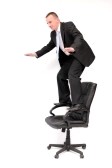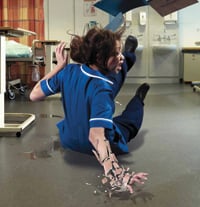Slips, trips, and falls are some of the worst yet most common type of office injuries in the workplace, but they are also the easiest to correct.
Office safety is very essential in today's world. Not only is it essential but it is also very important to be aware of several safety rules and regulations as this could hamper the smooth functioning of your office due to legal issues. This article does not focus on the legislation regarding workplace safety, but on providing several tips for ensuring that you and your employees have a safe working environment. Staying alert minimizing the risk!
Be sure take time to look around your work area and help to prevent these hazards. Slips, trips, and falls constitute the majority of general industry accidents and can result in back injuries, sprains and strains, contusions, and fractures. Slips, trips and falls, sidelined 25,790 workers in 2008, according to the Bureau of Labor Statistic (BLS). The National Safety Council says employees are twice as likely to suffer a disabling fall in an office setting as anywhere else. Falling, specifically, is the most common office accident and results in numerous and disabling injuries.
Slips & Falls
 Standing on chairs – particularly rolling office chairs – is a significant fall hazard. Workers who need to reach something at an elevated height should use a stepladder. Stepladders must be fully opened and placed on level, firm ground. Workers should never climb higher than the step indicated as the highest safe standing level.
Standing on chairs – particularly rolling office chairs – is a significant fall hazard. Workers who need to reach something at an elevated height should use a stepladder. Stepladders must be fully opened and placed on level, firm ground. Workers should never climb higher than the step indicated as the highest safe standing level.
Carpeting and other skid-resistant surfaces can serve to reduce falls. Marble or tile can become very slippery – particularly when wet, according to the National Safety Council. Placing carpets down can be especially helpful at entranceways, where workers are likely to be coming in with shoes wet from rain or snow.
Some other simple changes to the workspace can be effective in eliminating hazards and reducing the number of fall injuries.
- Clean up all spills immediately

- Close all file cabinets when not in use
- Ensure sufficient lighting
- Always use a ladder or stepstool to retrieve anything above shoulder level
- Remove obstacles from hallways and other high-traffice areas
- Do not lean back in chairs
- Regularly have the floors moped clean and dry
If you feel yourself falling, try to hit on your shoulder and roll. You are most likely to absorb more of this impact than falling straight. Don’t reach out with a hand or arm to break your fall, as it may result in a broken limb or hand.
- Tripping over open drawers or file drawers

- Tripping over electrical cords or wires that run across hallways
- Tripping over loose carpet or broken tiles or concrete
- Tripping over objects stored in a hallway, walkway or other areas of high traffic
- Tripping because of poor lighting
- Tripping over non-secure mats and rugs
Another major type of injury in the office setting comes from workers being struck by or caught by an object. Incidents of this nature accounted for 15,680 injuries in 2008, according to BLS.
- Shut the drawer!
- File cabinets with too many fully extended drawers could tip over if they are not secured, the council warns. Additionally, open drawers on desks and file cabinets pose a tripping hazard, so be sure to always completely close drawers when not in use.
- Safe stacking
- According to the Office of Compliance (OOC), which oversees the safety of U.S. congressional workers, proper storage of heavy items can help reduce the number of office injuries. Large stacks of materials and heavy equipment can cause major injuries if they are knocked over. OOC recommends storing heavy objects close to the floor, and warns that the load capacity of shelves or storage units should never be exceeded.
Report it
 Anytime you see something unsafe, report it to your facilities management department or supervisor. Things you might want to point out include sightings of:
Anytime you see something unsafe, report it to your facilities management department or supervisor. Things you might want to point out include sightings of:
- Torn carpet
- Loose tiles
- Wobbly steps or floorboards
- Burned out light bulbs
- Broken chairs or desks
- Other defective equipment
- Stray electrical cables or obstructions of walkways
- Possible unauthorized visitors
Promoting safety in the office can be simple with a few great office safety tips. There are many ways to share office safety tips in the workplace. You could have annual safety meetings where the entire company gets together to discuss current safety issues. They are also a great way to implement new safety rules. The biggest benefit of office safety meetings is that any person that has a question can have it answered by you or others in the group.
For the time in between safety meetings you can hang safety posters around the office. The posters can have office safety tips written on them. This will help employees to remember what they learned at the meetings long after they are over.
Safety in the workplace involves making arrangements so as to avoid accidents. At the same time, it also involves being alert to certain hazards and having knowledge about the measures used to overcome them. Here are some examples of the knowledge you & your employers should have regarding office safety.
- Keep your working area neat and clean
- Piles of papers and stacks of files combined with a tangle of wires are a disaster waiting to happen, on several fronts. A clean work space will also enable you to identify a problem and tackle it faster and more effectively.
- Any common area break room should be kept clean.
- There should be trash cans that are emptied on a daily basis. A broom, mop and other cleaning supplies should be in a closet or close by encase of spills.
Knowledge is power. Safety should be everyone’s top concern.
Training is, again, and extremely important tool in promoting office safety. We can prevent or greatly reduce these types of accidents if we train our people to:
- Not run in the office
- Avoid excessive bending, twisting, or leaning backwards while are seated
- Always use a ladder and not a chair for reaching
- Wear stable shoes
- Do not carry anything that obstructs your vision
Administrative controls
In addition to employee training and improved equipment, certain administrative controls can aid hazard recognition and the elimination of potentially dangerous situations.
- Conduct walkthroughs.Periodically walking around the office can help with hazard recognition and maintenance of ergonomic task design.
- Monitor signs of musculoskeletal disorders (MSDs). Recognizing the symptoms of MSDs can alert employees of the need to make an ergonomics alteration to their workstation. But workers need to know what those warning signs are.
- Talk to employees about their concerns. Simply asking workers how they are feeling can go a long way toward recognizing hazards.
- Establish employee reporting systems. Establishing an employee reporting system can be the best way for organizations to get a handle on potential hazards before they cause injury. Consider creating an anonymous reporting process that encourages workers to come forward with their concerns.
 An office environment is considered to be one of the safest work environments, therefore to ensure a safe work environment; each individual must employ common sense, know physical limitations, display an attentive attitude towards their surroundings, and become aware of applicable compliance codes.
An office environment is considered to be one of the safest work environments, therefore to ensure a safe work environment; each individual must employ common sense, know physical limitations, display an attentive attitude towards their surroundings, and become aware of applicable compliance codes.
Safety Training Services, Inc. can help! Whether its general office safety training topics like OSHA-compliance training (OSHA-10 General Industry), safety auditing or even rescue serices available to your company, contact us to find out how we can become your all-inclusive safety company!

